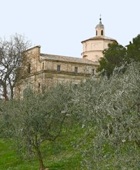
In 1462, a certain Pancascio, a native of Bevagna, fell mortally ill in Rome. He prayed that the Virgin would grant him enough time to return to his own city, and when he achieved this, he expressed his thanks by erecting a wayside tabernacle on this site to enclose a fresco that he painted of the Madonna delle Grazie (see below).

Pope Sixtus V (1585-90) gave the church to the Compagnia della Misericordia, perhaps while it was still in construction.
The church was closed for restoration during my visit in 2010. It can apparently be visited now by arrangement with the priest at Sant’ Agostino.
Exterior

The façade originally had a tympanum like that in the model, but it was subsequently demolished.
Interior
The interior is in the form of a nave and two aisles.
The marble high altar dates to 1641.
Madonna delle Grazie (1462)
The church was built to house this detached fresco by Pancascio on the main altar. It depicts the Madonna and Child enthroned and is considered to be miraculous (see above).
Madonna and Child (15th century)
This detached fresco is in the right transept.
Crucifix (15th century)
This wooden Crucifix is in the left transept.
Works by or Attributed to il Fantino
Ascensidonio Spacca, il Fantino was documented as head of the workshop here in 1617. The works associated with him are:
-
✴an altarpiece (1603) the Madonna di Constantinopoli with St Joseph and the donor, Crispolto Giorgi; and
-
✴other altarpieces (early 17th century) that are attributed to him:
-
•the Annunciation, on the 1st altar on the right;
-
•St Charles Borromeo in prayer, on the 1st altar on the left; and
-
•the Assumption of the Virgin, on the 2nd altar on the left, which is in two parts:
-
-the assumption itself; and
-
-the Apostles at the empty tomb.






